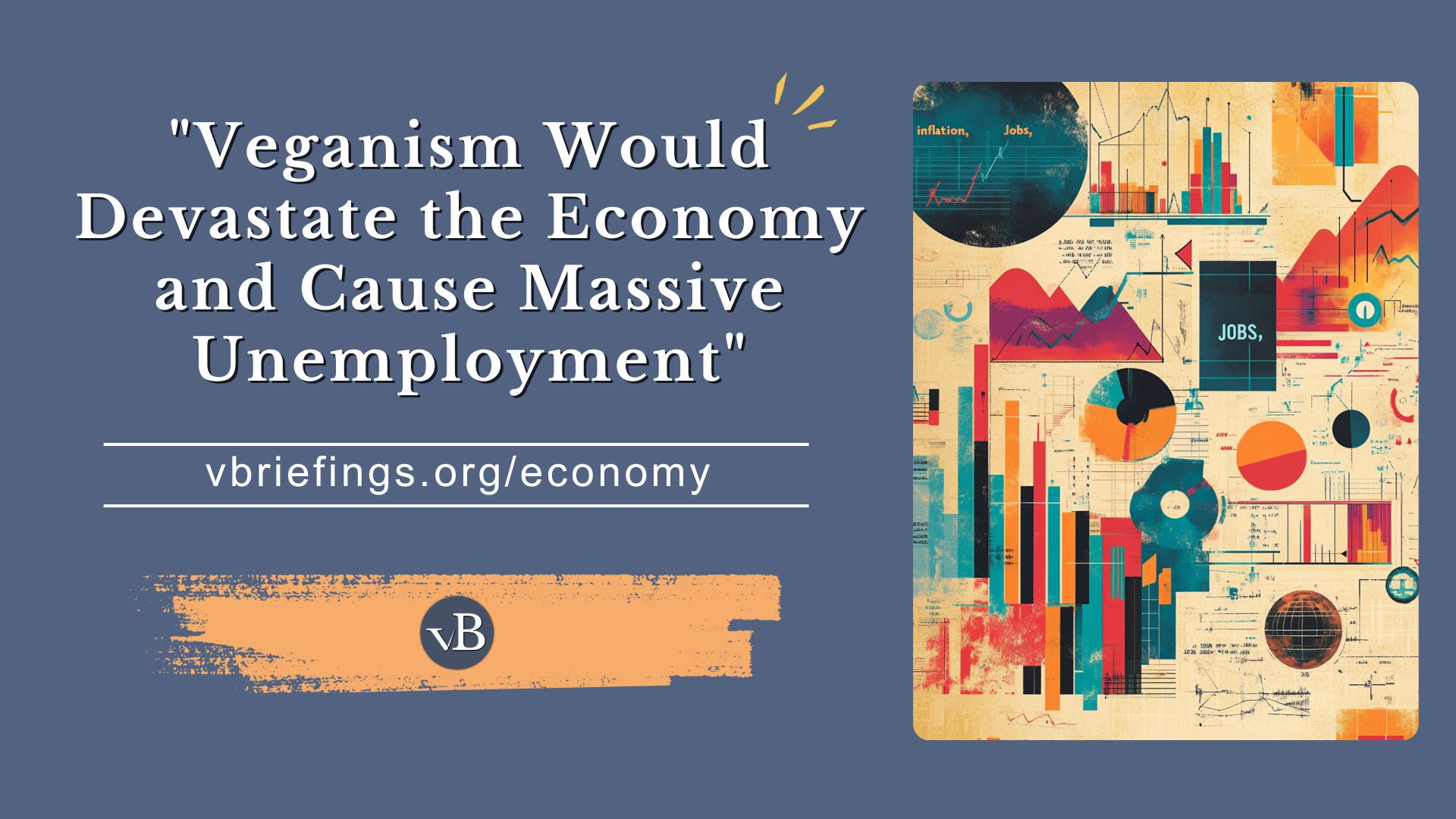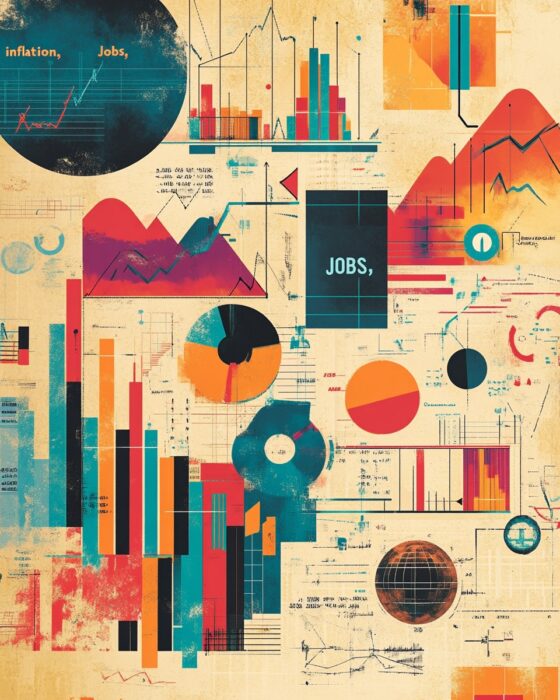Preface
Briefing description and more.
This briefing shows that a transition to plant-based food systems can be managed effectively and may yield significant economic and societal benefits.
Companion Videos
How to use companion videos
Videos may be posted on multiple social media platforms, and you can share them on each platform according each platform’s conventions.
Share this Briefing
Social Media Sharing Image
This image will be used when sharing the briefing on a social media platform. You can see all social sharing images in the grid view.

How to share this briefing
Click on the icon for the platform on which you wish to share. What happens next depends on the platform, but generally a popup will appear, letting you add your own text as you share.
Briefing Meta
Metrics
Note: we will publish additional briefings after completing flashcards and presentation slides for selected briefings.
Counts:
| Main Text | |
| Key Points | 6 |
| Counterclaims | 0 |
| Supplementary | 1 |
| Further Study | 1 |
| Footnotes | 24 |
| Media & Advocacy | |
| Advocacy Notes | 9 |
| —Socratic Questions | 9 |
| Flashcards | 0 |
| Presentation Slides | 0 |
| Memes & Infographics | 0 |
| Companion Videos | 0 |
Other Meta:
Date Posted:
Last Edited:
Edit Log:
Key Points Links
Loading…
Help Us Improve
Please send your suggestions for improvements, or report any issues with this briefing to team@vbriefings.org
We appreciate that you are taking the time to help up improve. All suggestions and reports will be carefully considered.
Summary
A concise summary of the briefing (see below for citations).
A global shift to veganism is often portrayed as an economic disaster—visions of farmers and meat industry workers en masse losing their livelihoods. In reality, such a transition would be gradual and manageable. History shows that economies can adapt to major shifts in production, and a move toward plant-based food systems could strengthen economic stability in the long run. New industries would emerge to replace old ones, net benefits in health and environment would save trillions, and societies have repeatedly chosen ethical progress despite dire economic predictions. With programs already helping farmers transition to plant-based models, a carefully navigated vegan transition can be economically beneficial.
Context
Places this topic in its larger context.
The transition toward more plant-based diets represents just one aspect of broader food system transformations occurring worldwide. Multiple factors, including urbanization, income growth, technological innovation, and increasing awareness of sustainability, drive these changes.1
Veganism intersects with broader trends of sustainability and technological change. Environmental imperatives are already driving shifts in energy and transportation; food is another frontier. A plant-based food economy aligns with efforts to curb climate change and improve public health—goals which themselves carry economic weight.
As with previous economic transitions throughout history, this shift presents both challenges for established industries and opportunities for emerging ones, raising important questions about how to manage change in ways that protect vulnerable communities while capturing potential benefits.
Key Points
This section provides talking points.
Economies will have time to adjust.
The world will not go vegan overnight. Any shift in diets would occur over years or decades, allowing markets and workers to transition gradually.
With ample time to adapt, farmers can shift to growing crops, and companies can diversify into alternative proteins. Studies suggest a gradual transition, with one analysis projecting that by 2040, most meat consumption will come from plant-based or cultured alternatives rather than slaughtered animals (an AT Kearney analysis, as reported by The Guardian).2
Recent modeling studies suggest that even ambitious scenarios, such as global substitution of 50% of animal products with plant-based alternatives by 2050, would occur over multiple decades.3 This timeframe allows for measured economic transitions rather than abrupt displacement.4
Policy can further cushion the change: governments could offer retraining programs or subsidies to help agricultural communities transition to new livelihoods. In short, the shift toward veganism can be managed through a transition over time, not an abrupt shock.5
Veganism will actually benefit the economy.
A global shift away from animal products isn’t just about reducing harm—it could drive economic revitalization. By eliminating the costly inefficiencies of using animals as intermediaries in food production, societies can streamline their systems, reduce waste, and save billions in healthcare and environmental costs, all while creating jobs and expanding new industries that support public well-being.
- More Plants, More Jobs. A 2025 Faunalytics study suggests that shifting toward more plant-based eating could result in considerable job creation. A scenario with moderate growth results in a few thousand new jobs, while significant growth leads to the creation of tens of thousands. In both scenarios, more plant-based eating corresponds to more job creation.6
- Higher GDP and Tax Revenue. A move toward a plant-based economy could realistically boost both GDP and tax revenue. According to the same 2025 Faunalytics study that projected job growth, a substantial expansion of the plant-based sector could add about 4% more to the U.S. GDP and increase total tax revenue by around 2%.7
- Healthcare Savings. A study published by the National Academy of Sciences calculates a health-care savings of around $1,067 billion annually with a vegan diet.8 That’s over $3,000 for each person in the United States. Savings stem from the reduced need for medical care, as a vegan diet tends to decrease the likelihood of health issues.
- Environmental Savings. A transition to plant-based food systems, which generally have a significantly lower environmental footprint, can lead to substantial cost reductions. Similar to healthcare savings, reduced environmental damage means fewer resources are spent on cleanup, disaster recovery, and managing the consequences of resource scarcity, all of which are real economic costs.
- A 2023 study published in Nature Food found that reducing consumption of animal-based foods could avoid up to $5.7 trillion in economic losses tied to ecosystem quality decline. These avoided costs reflect reduced environmental damage such as deforestation, land degradation, and biodiversity loss, demonstrating how dietary shifts can help protect natural systems that are critical to long-term economic resilience.9
- An Oxford Martin School study estimated that the economic benefits derived from reduced greenhouse gas emissions resulting from dietary changes could amount to as much as $570 billion (globally) annually.10
Many would choose principles over economic impact.
People are willing to pay more. Even if a vegan transition does entail economic adjustments, people often prioritize ethics and sustainability over short-term financial considerations. We’ve seen this in public opinion and historical actions.
- While we advocate for an end to animal exploitation rather than incremental welfare reforms, it’s telling that many Americans are willing to spend more to reduce animal suffering within the current system. According to a 2024 American Humane survey of 1,003 U.S. adults, 58% said they would pay a premium for products labeled as humanely raised.11
- A PwC global consumer survey in 2024 found consumers willing to spend nearly 10% more, on average, for sustainably produced goods—evidence that principles (like sustainability) can trump pure price concerns.12
Economies have historically weathered transitions and emerged stronger.
Economies have historically shown resilience and adaptability during major transitions, such as the Industrial Revolution, automation, and the decline of key industries like whaling. These shifts typically span decades, allowing time for societal adjustment and economic restructuring.
Examples:
- The mechanization of agriculture in the 20th century caused far more significant employment disruption than dietary shifts would likely produce. For example, in 1900, about 40 percent of the U.S. workforce was employed in agriculture; by 2000, that share had dropped to under 2 percent.13 Yet, economies successfully adapted through worker migration to other sectors, educational investments, and the development of new industries that absorbed displaced labor. The economy didn’t collapse; it evolved and grew stronger.14
- Another example of how the economy can adapt is what happened when cars replaced horse-drawn carriages in the early 1900s. Jobs tied to horses—like carriage makers, blacksmiths, and stable hands—faded out, but at the same time, the booming auto industry created millions of new jobs in areas like car manufacturing, maintenance, gas stations, and building roads from 1910 to the 1930s.15
- The decline of the whaling industry, once a significant economic pillar, was gradually superseded by the use of petroleum. These innovations, coupled with the increasing scarcity of whales due to overhunting, rendered whaling economically unsustainable. As a result, capital and labor transitioned to burgeoning industries like petroleum refining, illustrating how technological progress can redirect economic structures and labor markets.16
Economic transitions are the norm, not the exception.
Change is the only constant in the economy. Entire industries have faded—such as telephone operators, VHS rental stores, and print newspaper jobs—while new ones have emerged, including cellular networks, streaming services, and digital media. There’s no reason to think that phasing out animal exploitation would defy this trend. In fact, it will continue to drive innovation in areas like protein production and cruelty-free fashion, creating new, diverse job opportunities.
Historical moral shifts were embraced despite economic fear-mongering.
When society has decided something is fundamentally wrong, it has acted despite dire economic warnings.
- Abolition of slavery in the 19th century is an example: opponents argued Britain’s wealth “rested on goods produced by slaves” and that ending the slave trade would destroy jobs and prosperity. Moral conviction prevailed, slavery was abolished, and the economy adapted and grew through the Industrial Revolution.17
- Industries once warned that banning child labor would cripple the economy, citing increased costs and job losses. Yet society ultimately chose to protect children, prioritizing ethical progress over profit. Over time, the economy adapted to the new standards. This reflects a broader truth: people are often willing to support economic shifts in the service of humane and moral advancement.18
Counterclaims
Responses to some yes but retorts.
Counterclaims are often not included in objection-type briefings because the objection itself functions as a form of counterargument.
Supplementary Info
Additional information that may prove useful.
Farm Transition Programs
Several organizations are helping farmers transition from raising animals to cultivating plant-based foods. These programs offer financial, technical, and emotional support to farmers who are ready to transition toward more sustainable and compassionate livelihoods.19
- Transfarmation Project (Mercy for Animals). Mercy for Animals launched the Transfarmation Project to support farmers seeking to move away from industrial animal agriculture. The initiative helps farmers repurpose their land and infrastructure to cultivate mushrooms, leafy greens, hemp, and other crops. The program offers feasibility studies, transition planning, market development, and long-term guidance to ensure economic viability and sustainability.20
- Farm Transitions Program (Animal Outlook). Animal Outlook’s Farm Transitions Program offers a structured, six-stage blueprint to help farmers shift from animal-based to plant-based farming. Led by agronomist Dr. Timothy Bradford Jr., the program includes site assessments, business modeling, legal and financial consulting, crop selection guidance, and animal rehoming strategies. The initiative emphasizes personalized support and scalable solutions that can be adapted across farm types and regions.21
- The Farmer Toolkit. The Farmer Toolkit, developed in partnership by Animal Outlook and Mercy for Animals, is a free online resource that provides detailed guidance for farmers interested in transitioning. It includes crop profiles, infrastructure conversion guides, enterprise budgets, and market planning tools. The toolkit also connects farmers with transition consultants and webinars, helping to demystify the process and build confidence in plant-based models.22
- Case Study: Bill Ferguson’s Poultry Farm. Bill Ferguson, a former poultry farmer in Southeast Alabama, partnered with Animal Outlook to transition his operation into a hydroponic lettuce farm. Facing mounting challenges as a contract chicken grower, Ferguson retrofitted his poultry barns to grow leafy greens destined for local schools and grocery stores. His first harvest in May 2025 marked a successful example of rural economic renewal through plant-based agriculture.23
Further Study
Sources providing a deeper understanding of the topic or related topics.
Other Resources
The 2025 Faunalytics report, “The Economic Impacts Of A Plant-Based Transition,” offers specific projections for the United States regarding job creation, GDP impact, and tax revenue under different scenarios of plant-based market growth.24
Advocacy Resources
Information to help with outreach and advocacy.
Note: we will publish additional briefings after completing flashcards and presentation slides for selected briefings.
Share This Briefing
Cloned from the Preface Section on page load.
Companion Videos
Cloned from the Preface Section on page load.
Memes and Infographics
No images found.
How to use Memes and Infographics
To sequence through all memes and infographics on this page, click on any image than use the arrow keys or the arrow buttons to show next and previous images.
To share a meme or infographic, right click on the image and choose download or save as. Then upload the image to the platform of choice.
Presentation Slides
Slides not available.
How to Use the Presentation Slides
You can view the slideshow full screen by clicking on the first link above.
To use Canva presenter mode, view the speaker notes, or download the slides as PowerPoint, login to Canva (the free account works) and follow the Full Canva Link provided above.
To copy this presentation to your own Canva project, use the Full Canva Link provided above, then select File->Make a Copy from the upper left. You can build your own unique presentation from multiple briefings by copying the presentation from each briefing and then building another presentation from the copied presentations.
Flash Cards
We partner with Brainscape because of their excellent features for learning. You will need to create a free Brainscape account to study the cards.
Go to Flash Cards: This will take you to a list of decks.
About Flash Cards and Brainscape
Flash cards are here to help you commit important facts and concepts in this briefing to memory.
In Brainscape, there is one deck for each briefing. You can study more than one deck at a time. Brainscape uses spaced repetition to promote memory retention. It is “the secret to learning more while studying less.”
You can study using your browser, but Brainscape also has a free mobile app that makes learning anywhere easy.
Socratic Questions
Socratic-style questions are embedded in the Advocacy Notes below, and shown in italics.
These are open-ended, thought-provoking questions designed to encourage critical thinking, self-reflection, and deeper understanding. They are inspired by the Socratic method, a teaching technique attributed to the ancient Greek philosopher Socrates, who would ask his students probing questions rather than directly providing answers.
The goal is to help people examine their beliefs, clarify their thoughts, uncover assumptions, and explore the evidence and reasoning behind their ideas.
Advocacy Notes
Tips for Advocacy and Outreach
Segue the conversation back to animal ethics.
- “If we know animals suffer in industries we no longer need for survival, isn’t the real question whether it’s right to keep exploiting them at all?”
Why? This reframes the conversation, reminding people that ethics—not just economics—is central to the discussion.
Point out that economies have adapted before.
- “When we stopped using whale oil, phased out child labor, or switched from horses to cars, didn’t we hear the same economic fears—and yet adapt and move forward?”
Why? This places the fear of change in historical context, showing that moral progress and economic adaptation can go hand in hand.
Highlight that change would be gradual.
- “Since transitions like these take decades, doesn’t that give time for industries, workers, and markets to evolve rather than collapse?”
Why? It calms fears about disruption by emphasizing the realistic timeline of change.
Emphasize job creation in the plant-based sector.
- “If the plant-based sector is already projected to create thousands—maybe tens of thousands—of new jobs, doesn’t that sound like opportunity rather than catastrophe?”
Why? It reframes the narrative as one of potential growth instead of loss.
Ask what kind of economy we want to support.
- “Would you rather support an economy built on needless animal suffering, or one that reflects growing values of compassion and sustainability?”
Why? It invites reflection on values, not just outcomes.
Note the economic benefits of healthcare and environmental savings.
- “If a shift toward veganism could save over a trillion dollars in healthcare and up to $5.7 trillion in environmental costs, doesn’t that make financial sense too?”
Why? It challenges the assumption that veganism is economically risky by pointing to measurable gains.
Underscore that ethical progress often wins despite economic warnings.
- “When society ended slavery or banned child labor, weren’t there people warning it would ruin the economy—but we did it anyway, because it was right?”
Why? It shows that justice-driven change has precedent, even when it challenges the status quo.
Emphasize personal responsibility.
- “If our purchases help maintain a system that depends on animal suffering and environmental harm, don’t we each play a role in sustaining or ending it?”
Why? It helps people confront their own complicity, making the issue harder to dismiss as abstract.
Respond to the idea that we’re just trying to protect jobs.
- “Should we keep supporting harmful industries just because they provide jobs, even when better, kinder alternatives exist?”
Why? It questions the logic of defending jobs at the cost of ethics and sustainability.
Footnotes
Our sources, with links back to where they are used.
- Aiking H, de Boer J. The next protein transition. Trends Food Sci Technol. 2020 Nov;105:515-522. doi: 10.1016/j.tifs.2018.07.008. Epub 2018 Jul 27. PMID: 38620223; PMCID: PMC7127173. ↩︎
- Carrington, Damian. “Most Meat in 2040 Will Not Come from Dead Animals, Says Report.” The Guardian, The Guardian, 12 June 2019, www.theguardian.com/environment/2019/jun/12/most-meat-in-2040-will-not-come-from-slaughtered-animals-report. ↩︎
- Kozicka M, Havlík P, Valin H, Wollenberg E, Deppermann A, Leclère D, Lauri P, Moses R, Boere E, Frank S, Davis C, Park E, Gurwick N. Feeding climate and biodiversity goals with novel plant-based meat and milk alternatives. Nat Commun. 2023 Sep 12;14(1):5316. doi: 10.1038/s41467-023-40899-2. PMID: 37699877; PMCID: PMC10497520. ↩︎
- Kozicka M, Havlík P, Valin H, Wollenberg E, Deppermann A, Leclère D, Lauri P, Moses R, Boere E, Frank S, Davis C, Park E, Gurwick N. Feeding climate and biodiversity goals with novel plant-based meat and milk alternatives. Nat Commun. 2023 Sep 12;14(1):5316. doi: 10.1038/s41467-023-40899-2. PMID: 37699877; PMCID: PMC10497520. ↩︎
- Mason-D’Croz D, Barnhill A, Bernstein J, Bogard J, Dennis G, Dixon P, Fanzo J, Herrero M, McLaren R, Palmer J, Rieder T, Rimmer M, Faden R. Ethical and economic implications of the adoption of novel plant-based beef substitutes in the USA: a general equilibrium modelling study. Lancet Planet Health. 2022 Aug;6(8):e658-e669. doi: 10.1016/S2542-5196(22)00169-3. PMID: 35932786; PMCID: PMC9364141. ↩︎
- Zach Wulderk. “The Economic Impacts of a Plant-Based Transition: Exploring Two Growth Scenarios – Faunalytics.” Faunalytics, 26 Mar. 2025, faunalytics.org/plant-based-economic-impacts/. Accessed 6 June 2025. ↩︎
- Zach Wulderk. “The Economic Impacts of a Plant-Based Transition: Exploring Two Growth Scenarios – Faunalytics.” Faunalytics, 26 Mar. 2025, faunalytics.org/plant-based-economic-impacts/. Accessed 6 June 2025. ↩︎
- via Springmann, Marco, H. Charles J. Godfray, Mike Rayner, and Peter Scarborough. “Analysis and Valuation of the Health and Climate Change Co-benefits of Dietary Change.” Proceedings of the National Academy of Sciences 113, no. 15 (April 12, 2016): 4146–51. ↩︎
- Lucas, E., Guo, M. & Guillén-Gosálbez, G. Low-carbon diets can reduce global ecological and health costs. Nat Food 4, 394–406 (2023). https://doi.org/10.1038/s43016-023-00749-2 ↩︎
- Springmann, M., Godfray, H. C., Rayner, M., & Scarborough, P. (2016). Analysis and valuation of the health and climate change co-benefits of dietary change. Proceedings of the National Academy of Sciences, 113(15), 4146-4151. https://doi.org/10.1073/pnas.1523119113. (The study is credited to the Oxford Martin School because it was conducted by researchers within one of its affiliated programs. ↩︎
- Ganzert, Robin. AMERICAN HUMANE FARM SURVEY. American Humane Association, 19 Nov. 2014, www.americanhumane.org/wp-content/uploads/2024/12/2024-Farm-Survey-Results.pdf. Accessed 29 May 2025. ↩︎
- “PwC’s Voice of the Consumer Survey 2024 Shrinking the Consumer Trust Deficit.” PWC, PWC Global, 15 May 2025, www.pwc.com/gx/en/issues/c-suite-insights/voice-of-the-consumer-survey.html. Accessed 29 May 2025. ↩︎
- Gross, Daniel. “U.S. Farms Still Feed the World, but Farm Jobs Dwindle.” Strategy+Business, 2 Aug. 2016, www.strategy-business.com/blog/US-Farms-Still-Feed-the-World-But-Farm-Jobs-Dwindle. ↩︎
- Olmstead, Alan L., and Paul W. Rhode. Creating Abundance: Biological Innovation and American Agricultural Development. Cambridge University Press, 2008.
↩︎ - Lacy, Robert. “Wheels of Change: The Automotive Industry’s Sweeping Effects on the Fifth District.” Www.richmondfed.org, Federal Reserve Bank of Richmond, 2003, www.richmondfed.org/publications/research/econ_focus/2003/winter/economic_history. ↩︎
- Kemp, John. “Energy Transitions: The Decline of Whale Oil and the Rise of Petroleum.” JKempEnergy.com, 8 Mar. 2024, jkempenergy.com/2024/03/08/energy-transitions-the-decline-of-whaling-and-the-rise-of-petroleum/?utm_source=chatgpt.com. Accessed 29 May 2025. ↩︎
- “The Case against Abolition | the Debate over the Slave Trade | Campaign against the Slave Trade | against Slavery | Bristol and Transatlantic Slavery | PortCities Bristol.” Discoveringbristol.org.uk, 2024, www.discoveringbristol.org.uk/slavery/against-slavery/campaign-against-slave-trade/debate/against-abolition/. ↩︎
- Cartwright, Mark. “Child Labour in the British Industrial Revolution.” World History, 12 Apr. 2023, www.worldhistory.org/article/2216/child-labour-in-the-british-industrial-revolution/. Accessed 29 May 2025. ↩︎
- “Animal Outlook’s Farm Transitions” Animal Outlook, https://animaloutlook.org/farm-transitions/. Accessed 30 May 2025. ↩︎
- “Transfarmation Project.” Mercy for Animals, https://thetransfarmationproject.org/. Accessed 30 May 2025. ↩︎
- “Animal Outlook’s Farm Transitions” Animal Outlook, https://animaloutlook.org/farm-transitions/. Accessed 30 May 2025. ↩︎
- “Farmer Toolkit.” Farmer Toolkit, https://farmertoolkit.org/start-your-transition/. Accessed 30 May 2025. ↩︎
- “Ferguson Farm Transition.” Animal Outlook, https://animaloutlook.org/farm-transitions-ferguson-farm/. Accessed 30 May 2025. ↩︎
- Zach Wulderk. “The Economic Impacts of a Plant-Based Transition: Exploring Two Growth Scenarios – Faunalytics.” Faunalytics, 26 Mar. 2025, faunalytics.org/plant-based-economic-impacts/. Accessed 6 June 2025. ↩︎




